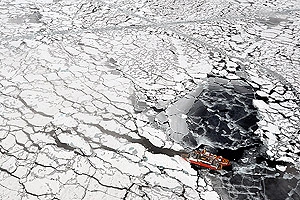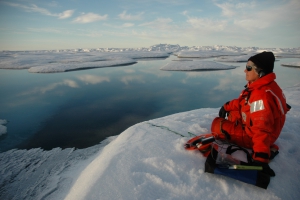Deploying a hydrophone takes preparation and precision in the deep ocean. The instruments need to be designed for the specific conditions they will endure and the length of time they will be deployed. They also need to be set up for the particular types of data they’re intended to record.
The arctic ocean is very cold, subject to storms and ice that limit the season and time when a hydrophone position can be accessed.
Ice bergs leave deep gouges in the ocean floor. This is called “scouring” and is one of the many hazards that make deployment and retrieval of Arctic hydrophones expensive and challenging. In the hostile Arctic environment the chances of hydrophones and other equipment being destroyed or lost are high.

Example of iceberg scouring on the Arctic seafloor

ARCTIC OCEAN – The Canadian Coast Guard Ship Louis S. St-Laurent ties up to the Coast Guard Cutter Healy in the Arctic Ocean Sept. 5, 2009. The two ships are taking part in a multi-year, multi-agency Arctic survey that will help define the Arctic continental shelf. Photo Credit: Patrick Kelley, U.S. Coast Guard
STEPS:1. Find a flat portion of seafloor for a 5- to 10-km diameter.
2. Determine the desired depth of deployment.
3. Construct a mooring, a combination of anchor and float attached to a cord that is designed not to stretch or vibrate (strum) which would affect the recording.
4. Drop the mooring by positioning the ship downwind 3-4 km and slowly move toward the deployment site releasing the mooring in a straight line to float into the water.
5. Attach a large yellow float, complete with a strobe light, a flag and a floating line, to help recover the mooring a year later.
6. Program and check the hydrophone before releasing it to start recording.
7. Set out an acoustic release device that can be commanded (by an acoustic signal) to release the apparatus for retrieval.
8. Release the anchor when the ship reaches the desired point. The mooring drops to the bottom dragging the hydrophone down into position.
9. Determine the anchor’s location by acoustically “pinging” the anchor release from various directions. This effort can be especially difficult during rough sea conditions which make the ship less maneuverable and can generate significant acoustic noise in the environment.
These steps are adapted from an article by Chris Fox, Principal Investigator Sound in the Sea Project, NOAA Pacific Marine Environmental, Laboratory, Newport, Oregon



